Reconstructing a Three-Dimensional Geological Model from Two-Dimensional Depositional Sections in a Tide-Dominated Estuarine Reservoir: A Case Study of Oil Sands Reservoir in Mackay River, Canada
Abstract
:1. Introduction
2. Geological Setting
3. Geological Dissection of Tidal Estuarine Reservoir
3.1. Stratigraphic Division and Correlation
3.2. Architectural Elements
3.2.1. FA1: Sandy Channel Filling
3.2.2. FA2: Point Bar
3.2.3. FA3: Salt Marshes
3.2.4. FA4: Point Bar in Tidal Channels
3.2.5. FA5: Mudflat
3.2.6. FA6: Mixed Flat
3.2.7. FA7: Sand Flat
3.2.8. FA8: Tidal Bar
3.2.9. FA9: Offshore
3.3. Reservoir Architecture
- 1.
- SF-TB1-SF
- 2.
- ST-TB1-SF
- 3.
- SF-SF
- 4.
- SF-MF
3.4. Factors Influencing the Reservoir Architecture Distribution
4. Reconstruction of 3D Geological Model from 2D Sections
4.1. Methods Introduction
4.2. Data Preparation
4.3. Model Construction and Analysis
5. Discussion
6. Conclusions
Author Contributions
Funding
Data Availability Statement
Acknowledgments
Conflicts of Interest
References
- Dalrymple, R.W.; Knight, R.J.; Zaitlin, B.A.; Middleton, G.V. Dynamics and facies model of a macrotidal sand-bar complex, Cobequid Bay-Salmon River Estuary (Bay of Fundy). Sedimentology 1990, 37, 577–612. [Google Scholar] [CrossRef]
- Bostock, H.C.; Brooke, B.P.; Ryan, D.A.; Hancock, G.; Pietsch, T.; Packett, R.; Harle, K. Holocene and modern sediment storage in the subtropical macrotidal Fitzroy River estuary, Southeast Queensland, Australia. Sediment. Geol. 2007, 201, 321–340. [Google Scholar] [CrossRef]
- Ryan, D.A.; Brooke, B.P.; Bostock, H.C.; Radke, L.C.; Siwabessy, P.J.; Margvelashvili, N.; Skene, D. Bedload sediment transport dynamics in a macrotidal embayment, and implications for export to the southern Great Barrier Reef shelf. Mar. Geol. 2007, 240, 197–215. [Google Scholar] [CrossRef]
- Liu, C.; Zhang, Q.; Xie, Y.; Qiao, L.; Sun, J.; Mei, X. Sequence Stratigraphic Framework and Development Model of the Cretaceous in Northeast Block, Oriente Basin, Ecuador. Acta Sedimentol. Sin. 2014, 32, 1123–1131. [Google Scholar] [CrossRef]
- Abdelwahhab, M.A.; Radwan, A.A.; Mahmoud, H.; Mansour, A. Geophysical 3D-static reservoir and basin modeling of a Jurassic estuarine system (JG-Oilfield, Abu Gharadig basin, Egypt). J. Southeast Asian Earth Sci. 2021, 225, 105067. [Google Scholar] [CrossRef]
- Zhou, H.; Huang, J.; Feng, W.; Liu, S.; Yin, Y. Analysis on formation factors and development characteristics of sand bar in tide-dominated estuaries—A case study based on Qiantang River. Geol. Rev. 2020, 66, 101–112. [Google Scholar] [CrossRef]
- Yang, B.; Dalrymple, R.W.; Gingras, M.K.; Chun, S.; Lee, H. Up-Estuary Variation of Sedimentary Facies and Ichnocoenoses in an Open-Mouthed, Macrotidal, Mixed-Energy Estuary, Gomso Bay, Korea. J. Sediment. Res. 2007, 77, 757–771. [Google Scholar] [CrossRef]
- Ji, Z.-G.; Hu, G.; Shen, J.; Wan, Y. Three-dimensional modeling of hydrodynamic processes in the St. Lucie Estuary. Estuar. Coast. Shelf Sci. 2007, 73, 188–200. [Google Scholar] [CrossRef]
- Dalrymple, R.W.; Choi, K. Morphologic and facies trends through the fluvial–marine transition in tide-dominated depositional systems: A schematic framework for environmental and sequence-stratigraphic interpretation. Earth-Sci. Rev. 2007, 81, 135–174. [Google Scholar] [CrossRef]
- Cheng, L.; Yin, Y.; Wang, H.; Feng, W.; Wang, L.; Liu, Z.; Wang, P.; Liu, J. Analysis of the internal architectural elements of tidal-influenced meandering fluvial deposits using well logging and seismic data: The study of the Athabasca Oil Sands, Alberta, Canada. Interpretation 2020, 8, SM103–SM114. [Google Scholar] [CrossRef]
- Tang, M.; Zhang, K.; Huang, J.; Lu, S. Facies and the architecture of estuarine tidal bar in the lower Cretaceous Mcmurray For-mation, Central Athabasca Oil Sands, Alberta, Canada. Energies 2019, 12, 1769. [Google Scholar] [CrossRef] [Green Version]
- Tang, M.; Lu, S.; Zhang, K.; Yin, X.; Ma, H.; Shi, X.; Liu, X.; Chu, C. A three dimensional high-resolution reservoir model of Napo Formation in Oriente Basin, Ecuador, integrating sediment dynamic simulation and geostatistics. Mar. Pet. Geol. 2019, 110, 240–253. [Google Scholar] [CrossRef]
- Tang, J.F.; Tang, M.M.; Lu, S.F.; Liu, X.P.; Zhang, K.X.; Hua, H.T.; Han, D. Three-Dimensional Modeling of Estuary Reservoir Based on Coupling Sedimentary Dynamics Simulation and Multipoint Geostatistics Method[J/OL]. Earth Science. Available online: http://kns.cnki.net/kcms/detail/42.1874.P.20220621.1503.016.html (accessed on 7 October 2022).
- Okabe, H.; Blunt, M.J. Prediction of permeability for porous media reconstructed using multiple-point statistics. Phys. Rev. E 2004, 70, 066135. [Google Scholar] [CrossRef] [PubMed] [Green Version]
- Okabe, H.; Blunt, M.J. Pore space reconstruction using multiple-point statistics. J. Pet. Sci. Eng. 2005, 46, 121–137. [Google Scholar] [CrossRef]
- Comunian, A.; Renard, P.; Straubhaar, J. 3D multiple-point statistics simulation using 2D training images. Comput. Geosci. 2011, 40, 49–65. [Google Scholar] [CrossRef] [Green Version]
- Takamura, K. Microscopic structure of athabasca oil sand. Can. J. Chem. Eng. 1982, 60, 538–545. [Google Scholar] [CrossRef]
- Carrigy, M.A. Geology of the McMurray Formation: General Geology of the McMurray AreaResearch Council of Alberta. Geological Division. 1959, 1, 130. [Google Scholar]
- Hein, F.J.; Cotterill, D.K. The Athabasca Oil Sands—A Regional Geological Perspective, Fort McMurray Area, Alberta, Canada. Nonrenewable Resour. 2006, 15, 85–102. [Google Scholar] [CrossRef]
- Barton, M.D.; Seibel, C. The architecture and variability of valley-fill deposits within the Cretaceous McMurray Formation, Shell Albian Sands Lease, northeast Alberta. Bull. Can. Pet. Geol. 2016, 64, 166–198. [Google Scholar] [CrossRef]
- Phillips, J. Sedimentology, Ichnology, and Development of a Sub-Regional Depositional and Stratigraphic Framework for the McMurray-Wabiskaw Succession in the MacKay River Area, Northeastern Alberta. Master’s Thesis, University of Alberta, Edmonton, AB, Canada, 2011. [Google Scholar] [CrossRef]
- Mutti, E. Turbidite Systems and Their Relations to Depositional Sequences. In Provenance of arenites; Springer: Dordrecht, The Netherlands, 1985; pp. 65–93. [Google Scholar] [CrossRef]
- Dalrymple, R.W.; Zaitlin, B.A.; Boyd, R. Estuarine facies models; conceptual basis and stratigraphic implications. J. Sediment. Res. 1992, 62, 1130–1146. [Google Scholar] [CrossRef]
- Qi, Y. Research on Estuarine Facies Models. Bull. Geol. Sci. Technol. 1999, 1, 46–50. [Google Scholar]
- Zhang, T.; Lu, T.; Li, D. A method of reconstruction of porous media using a two-dimensional image and multiple-point statis-tics. J. Univ. Sci. Technol. China 2010, 40, 271–277. [Google Scholar]
- Zheng, T.; Hou, W.; He, S. An MPS-Based Simulation Algorithm for 3D Geological Structure with 2D Cross-Sections. J. Jilin Univ. 2019, 49, 1496–1506. [Google Scholar] [CrossRef]
- Hou, W.; Liu, H.; Zheng, T.; Shen, W.; Xiao, F. Hierarchical MPS-Based Three-Dimensional Geological Structure Reconstruction with Two-Dimensional Image(s). J. Earth Sci. 2021, 32, 455–467. [Google Scholar] [CrossRef]
- Okabe, H.; Blunt, M. Pore space reconstruction of vuggy carbonates using microtomography and multiple-point statistics. Water Resour. Res. 2007, 43. [Google Scholar] [CrossRef]
- Chen, Q.; Mariethoz, G.; Liu, G.; Comunian, A.; Ma, X. Locality-based 3-D multiple-point statistics reconstruction using 2-D geological cross sections. Hydrol. Earth Syst. Sci. 2018, 22, 6547–6566. [Google Scholar] [CrossRef] [Green Version]
- Wang, L.; Yin, Y.; Wang, H.; Zhang, C.; Feng, W.; Liu, Z.; Wang, P.; Cheng, L.; Liu, J. A method of reconstructing 3D model from 2D geological cross-section based on self-adaptive spatial sampling: A case study of Cretaceous McMurray reservoirs in a block of Canada. Pet. Explor. Dev. 2021, 48, 407–420. [Google Scholar] [CrossRef]


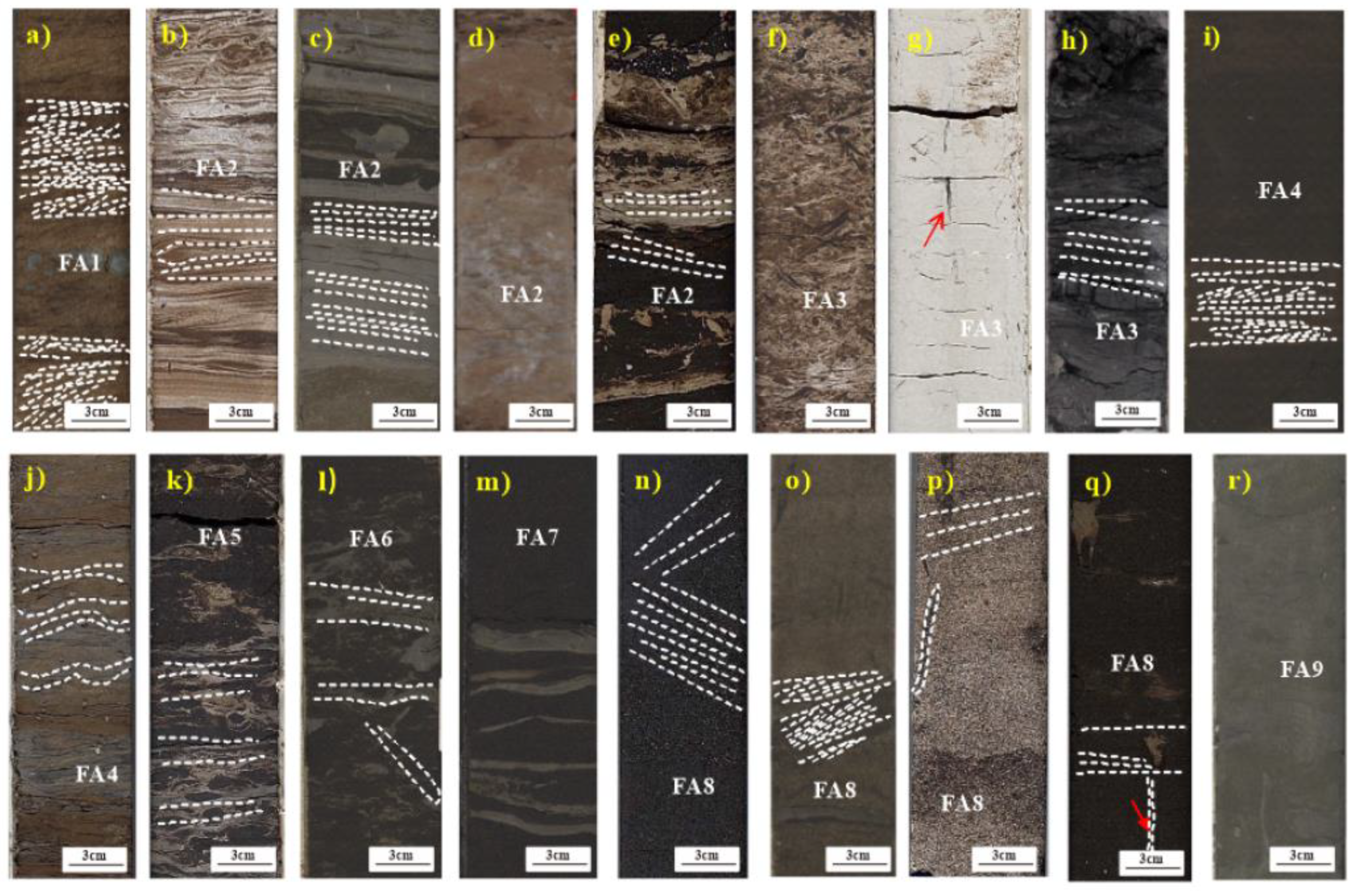
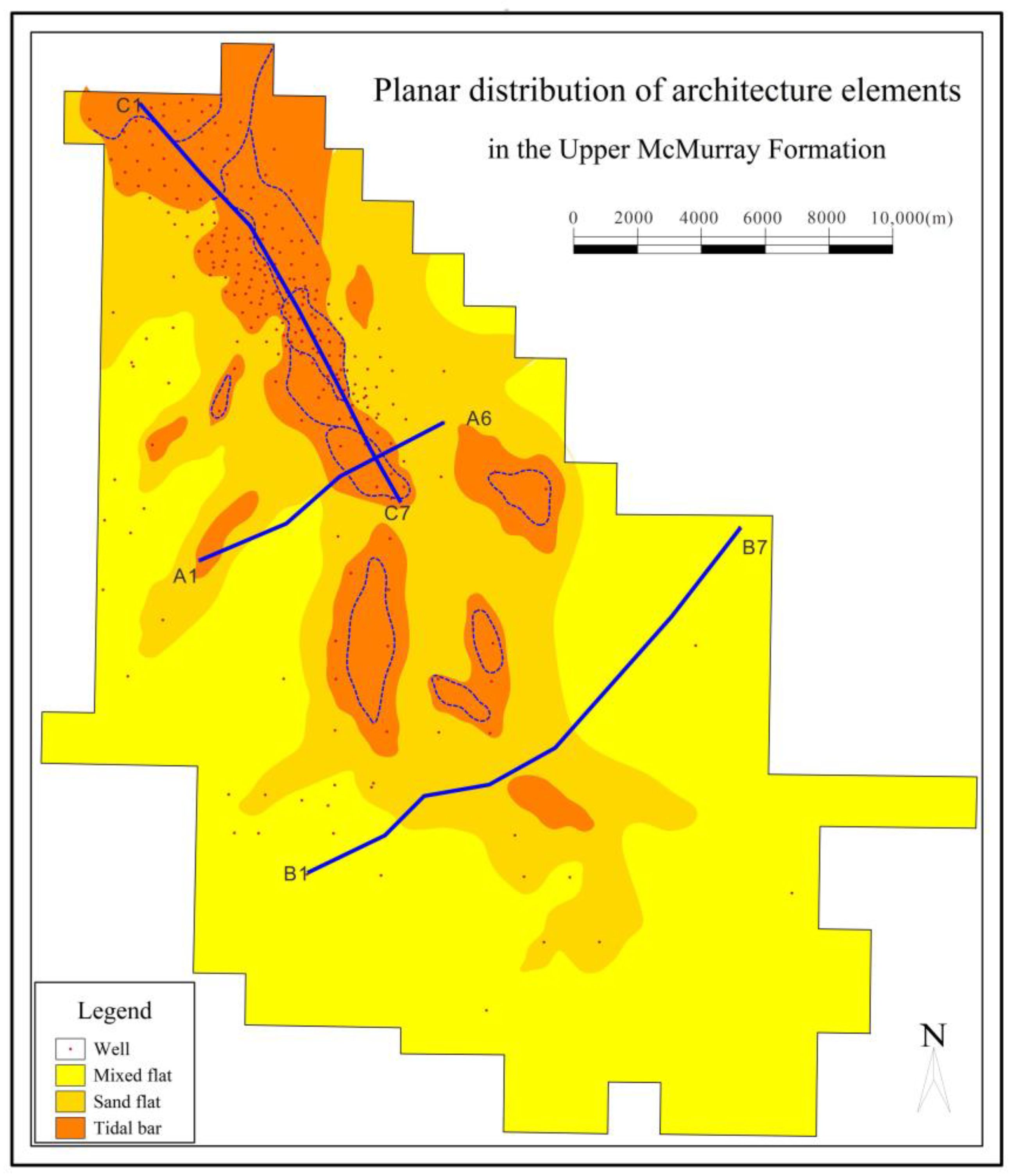




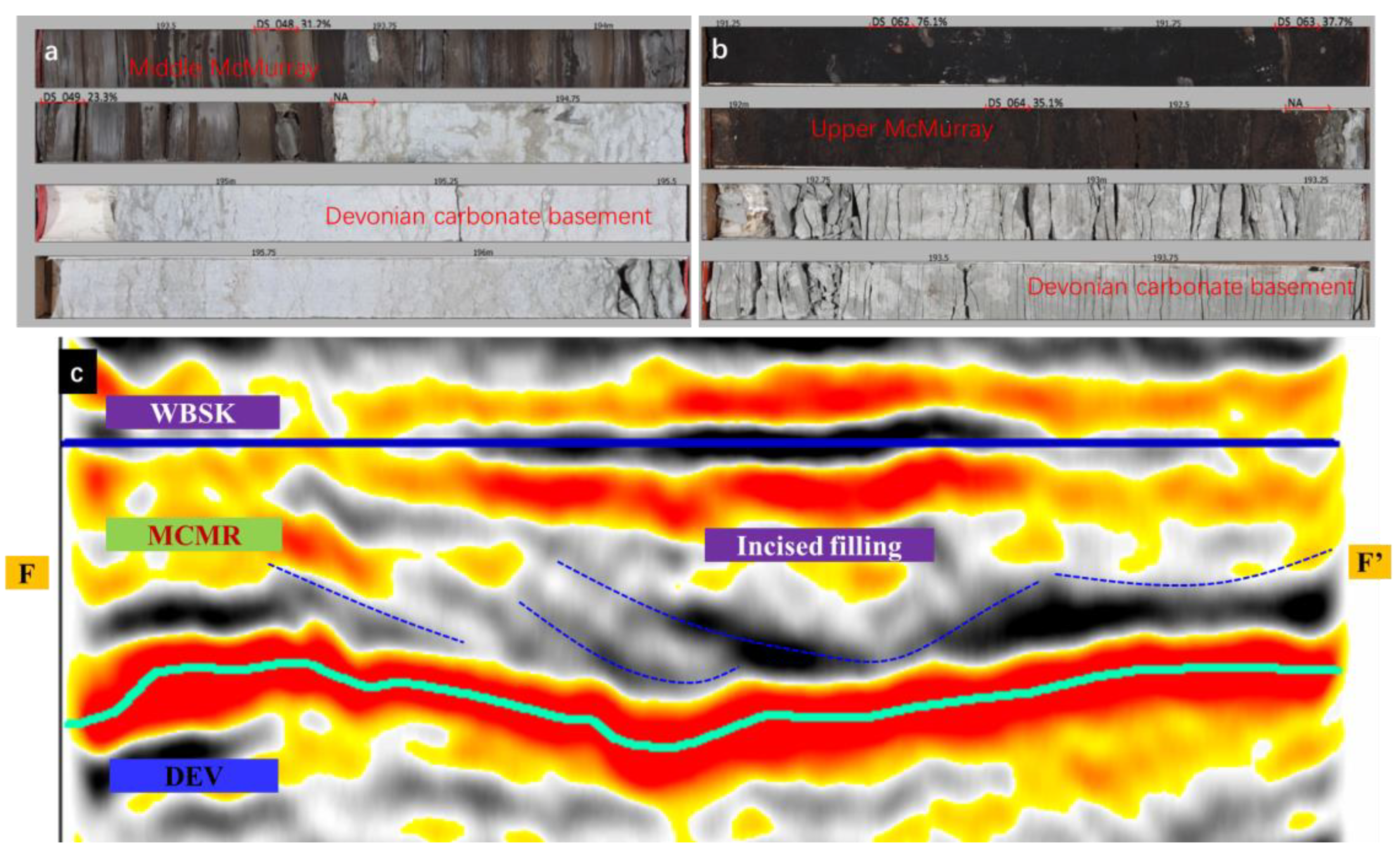
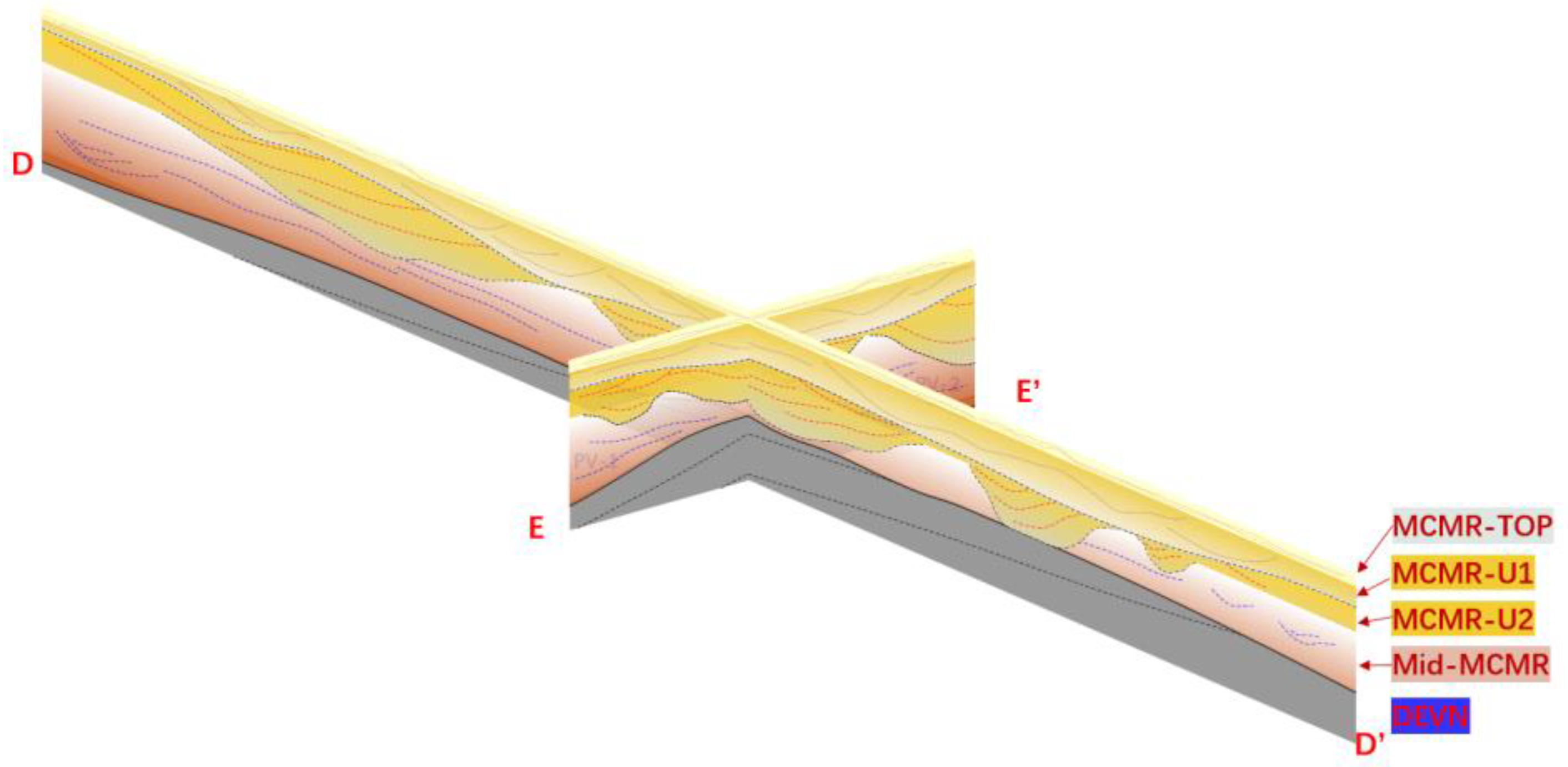




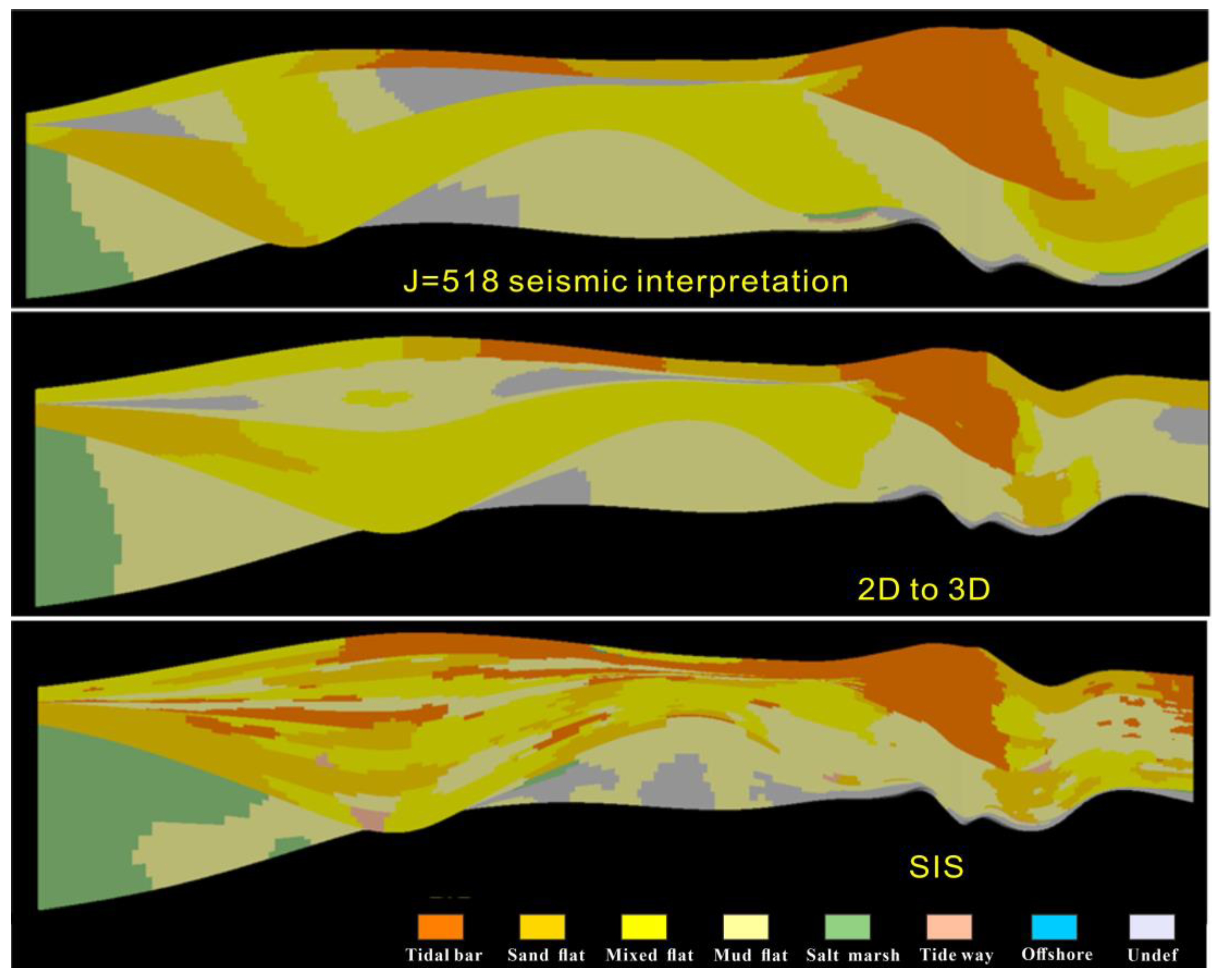
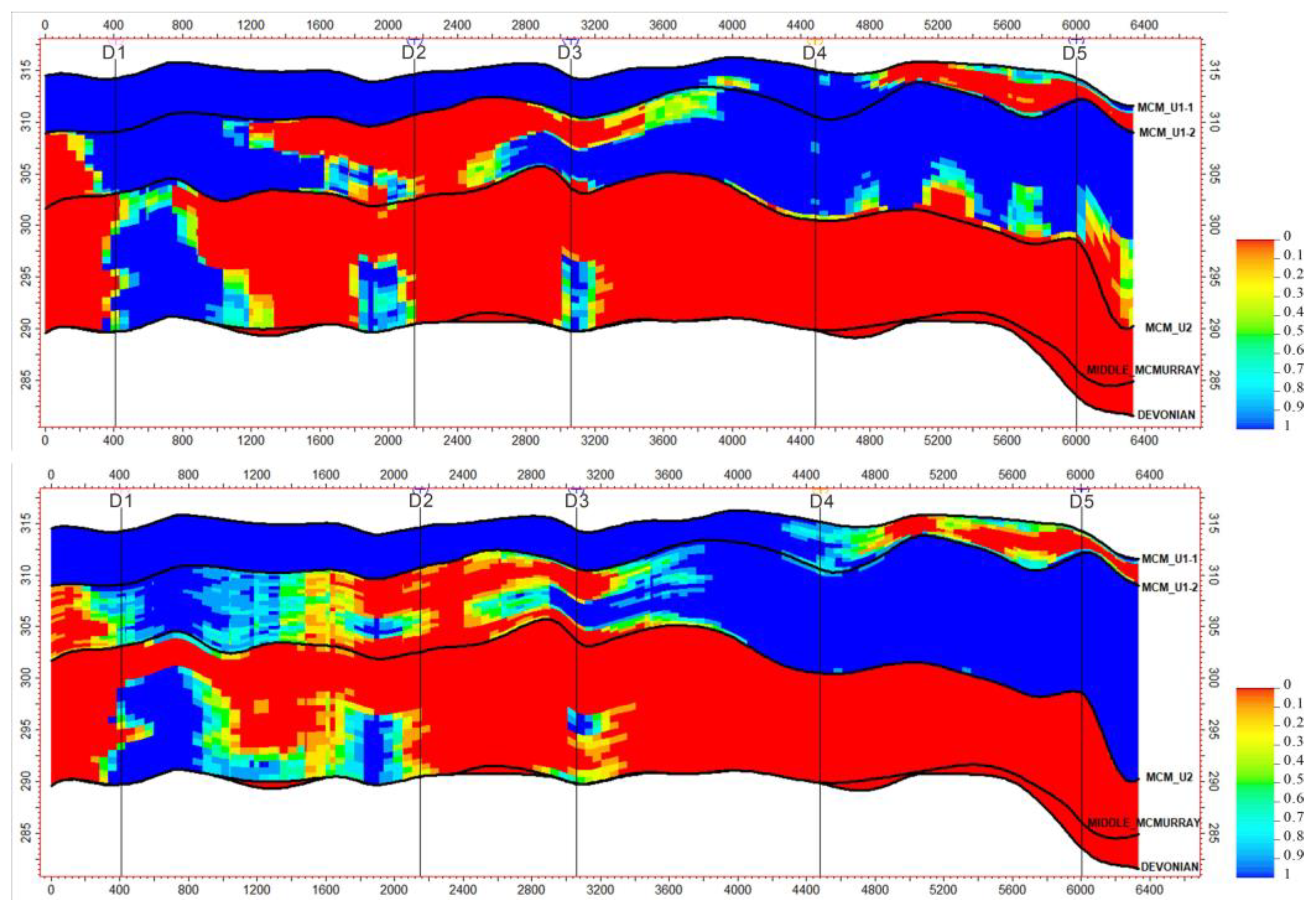
| 2D to 3D | SIS | |||
|---|---|---|---|---|
| Method | 2D training image acquisition mode, condition points as constraints. | Conditional data are used as constraints, and the curve fitting of variation function is used as input parameter constraints. | ||
| Simulation error | All | 33.13% | All | 57.25% |
| Tidal bar | 8% | Tidal bar | 11.5% | |
| Sand flat | 10% | Sand flat | 12.1% | |
| Error range | Tidal bar | 0%–35% | Tidal bar | 0%–42.2% |
| Sand flat | 0%–43.6% | Sand flat | 0%–51.6% | |
| Advantages | The reservoir architecture and morphology can be well captured from TIs so that the three-dimensional reservoir structure and morphology can be well reproduced. | Make good use of the existing geological information. Quick simulation. | ||
| Disadvantages | Simulation efficiency is low because of workload. | It cannot well-reflect the reservoir morphology and configuration superimposition style. | ||
Publisher’s Note: MDPI stays neutral with regard to jurisdictional claims in published maps and institutional affiliations. |
© 2022 by the authors. Licensee MDPI, Basel, Switzerland. This article is an open access article distributed under the terms and conditions of the Creative Commons Attribution (CC BY) license (https://creativecommons.org/licenses/by/4.0/).
Share and Cite
Huang, J.; Huang, J.; Yu, D.; Zhang, W.; Yin, Y. Reconstructing a Three-Dimensional Geological Model from Two-Dimensional Depositional Sections in a Tide-Dominated Estuarine Reservoir: A Case Study of Oil Sands Reservoir in Mackay River, Canada. Minerals 2022, 12, 1420. https://doi.org/10.3390/min12111420
Huang J, Huang J, Yu D, Zhang W, Yin Y. Reconstructing a Three-Dimensional Geological Model from Two-Dimensional Depositional Sections in a Tide-Dominated Estuarine Reservoir: A Case Study of Oil Sands Reservoir in Mackay River, Canada. Minerals. 2022; 12(11):1420. https://doi.org/10.3390/min12111420
Chicago/Turabian StyleHuang, Jiaxuan, Jixin Huang, Diyun Yu, Weixue Zhang, and Yanshu Yin. 2022. "Reconstructing a Three-Dimensional Geological Model from Two-Dimensional Depositional Sections in a Tide-Dominated Estuarine Reservoir: A Case Study of Oil Sands Reservoir in Mackay River, Canada" Minerals 12, no. 11: 1420. https://doi.org/10.3390/min12111420




